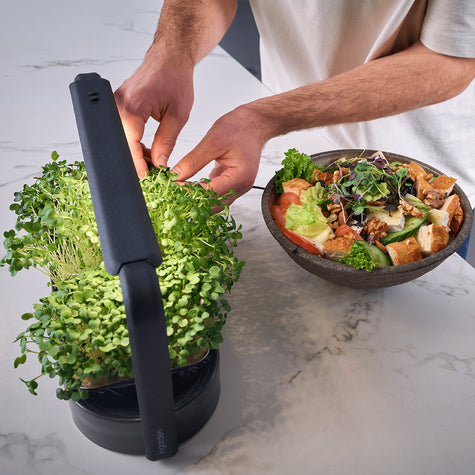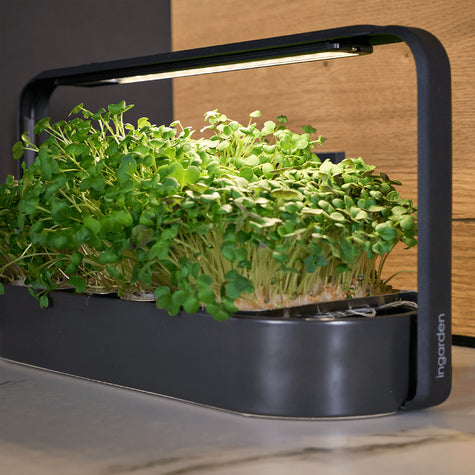Table of Contents
In the vibrant world of "superfoods you can grow at home," two candidates stand out as nutritional powerhouses: microgreens and sprouts. On this journey, we'll delve into the intricacies of these miniature greens, understanding their germination, growth, and the wealth of health benefits they bring to your plate. Choosing between microgreens and sprouts isn't just a culinary decision; it's a lifestyle choice that can enhance your well-being.
Germination process

Sprouts and microgreens share a common origin – the germination process. Understanding how each species begins its journey into life provides insight into the nutritional richness they offer.
Sprouts :
Sprouts begin their journey by activating the dormant seed embryo during germination. This essential process not only initiates growth but also prepares the ground for the release of nutrients. Seeds, previously inactive and lacking physiological function, come to life and unlock a range of vital compounds. The revitalized seed embryo paves the way for the subsequent development of the sprouts.
Microgreens :
The process for microgreens varies slightly. These tiny plants grow from seeds and are harvested shortly after the cotyledons appear, but before true leaves develop. This careful timing captures the essence of their immaturity, ensuring a unique flavor profile and a concentration of nutrients. Microgreens showcase the potential within the seed, offering a vivid snapshot of early plant life.
Harvest and size
Sprouts :
Sprouts typically reach their peak growth four to six days after germination. This short but effective phase provides a suitable size for harvesting, making them convenient for processing and marketing. Their delicate texture and concentrated nutrient content make them a sought-after addition to various culinary creations.
Since they are often grown in water, it is important to wash the seeds once or twice a day to prevent mold. This is also why it is recommended to cook sprouts before eating them, as they may contain bacteria that thrive in damp environments.
Microgreens :
Microgreens, on the other hand, require a bit more patience. Harvested between 7 and 21 days after germination, they reach a length of 5 to 10 cm. This carefully timed harvest captures the optimal moment after the cotyledons appear but before true leaves develop. The resulting size guarantees not only an explosion of flavor but also a visual spectacle with vibrant colors that enhances the aesthetics of your dishes.
Storage and shelf life
Understanding the differences in storage conditions and shelf life ensures that you can get the most out of your sprouts and/or microgreens.
Sprouts :
Sprouts, with their more robust structure, have a longer shelf life compared to their microgreen counterparts. When properly stored in the refrigerator, sprouts can retain their freshness for an extended period. This characteristic makes them a convenient choice for those who prefer to buy/store larger quantities.
Microgreens :
Microgreens, on the other hand, require immediate use. Rapid spoilage after harvesting is the nature of these delicate greens. When stored at room temperature, microgreens can be safely consumed within 1 to 2 days. A more convenient method is to harvest only the greens you actually need and leave the rest in their growing medium before proceeding with the harvest. This way, they will stay fresh longer.
Nutritional values
The key lies in the nutrient richness of sprouts and microgreens . Each variety of green boasts a unique blend of phytochemicals and offers a range of health benefits. Let's break down the complex details of amino acids, pectins, ash, sugars, organic acids, soluble solids, dry matter, and pH to unlock the comprehensive nutritional profiles that define these tiny greens.
Sprouts :
Sprouts are known for their high content of phytochemicals. These include various flavonoids, hydroxycinnamic acids, vitamins, glucosinolates, minerals, and carotenoids. The germination process gives sprouts a concentrated boost of these bioactive compounds, making them not only a flavorful addition to meals but also a source of essential nutrients that contribute to overall well-being.
- Amino acids : Sprouts prove to be a rich source of amino acids, the building blocks of proteins. This makes them an excellent addition to plant-based diets, providing essential proteins for overall health.
- Pectins : The presence of pectins in sprouts adds a soluble fiber component that aids digestion and promotes heart health.
- Sugar : Although sprouts contain sugar, their low calorie count and high nutrient content make them a healthy choice for those who are mindful of their sugar intake.
- Organic acids : The inclusion of organic acids contributes to the refreshing taste of sprouts and increases their culinary appeal.
However, sprouts are less nutrient-rich than microgreens and also contain less fiber. Raw sprouts can also pose a greater health risk, as improperly grown sprouts can contain bacteria.
Microgreens
Microgreens, on the other hand, present a different nutritional profile. They are known for their high content of carotenoids, chlorophylls, and organic acids. These vibrant compounds not only contribute to the visual appeal of microgreens but also offer unique health benefits. The combination of colors and bioactive compounds makes microgreens a flavorful and nutritious addition to salads, sandwiches, and various culinary creations.
- Carotenoids, chlorophylls, and organic acids : Microgreens are characterized by their high content of carotenoids, chlorophylls, and organic acids. These compounds contribute to their vibrant colors, fresh taste, and potential health benefits.
- Sugars and soluble solids : Microgreens exhibit a balance between sugars and soluble solids, offering a pleasant sweetness that complements a variety of dishes.
- Dry matter and pH value : The dry matter content and pH value of microgreens contribute to their overall texture and taste, offering a diverse culinary experience.
Understanding the complex nutritional values of sprouts and microgreens allows you to tailor your diet choices to your health goals.
Health benefits and uses
Sprouts and microgreens have a well-deserved reputation as health-promoting foods. Let's uncover the health benefits they offer and explore the many ways they can be seamlessly incorporated into your daily routine.
Sprouts :
Sprouts have long been celebrated as nutritional powerhouses, earning recognition for their high content of essential nutrients and bioactive compounds. Packed with flavonoids, hydroxycinnamic acids, vitamins, glucosinolates, minerals, and carotenoids, sprouts contribute significantly to overall health. Nutritionists often recommend sprouts for their potential role in protecting the body against chronic diseases such as cardiovascular disease, diabetes, and cancer. Their low calorie count and low glycemic index further enhance their appeal as a beneficial food.
However, due to their difficult germination process and higher risk of bacterial and mold contamination, sprouts should not be consumed by people with weakened immune systems or other medical conditions. Please consult your doctor if you are unsure whether you can grow sprouts at home. It is also recommended to cook sprouts before eating them.
Microgreens :
Microgreens, though relatively new to the scene, have rapidly gained popularity due to their health benefits. High levels of carotenoids, chlorophylls, and organic acids contribute to their nutritional profile. Studies suggest that microgreens exhibit higher anti-diabetic and anti-cholinergic activity compared to sprouts, adding another layer of health-promoting potential. The delicate texture, unique colors, and delicious flavor of microgreens make them not only nutritious but also a delight to incorporate into your daily meals.
Antioxidant capacity and biological activity

Beyond the realm of taste, sprouts and microgreens prove to be potent sources of antioxidants, contributing to their biological activity.
Sprouts :
Sprouts are distinguished by their robust antioxidant capacity, which stems from their high content of polyphenols and L-ascorbic acid. These antioxidants play a crucial role in neutralizing free radicals in the body and can potentially prevent oxidative stress. The polyphenols and L-ascorbic acid in sprouts not only contribute to their freshness but also to their ability to support the body's defenses against chronic diseases. This antioxidant strength adds an extra layer of health benefits to the already nutrient-rich profile of sprouts.
Microgreens :
Microgreens also exhibit remarkable antioxidant capacity, thanks to their rich content of carotenoids, chlorophylls, and organic acids. These compounds contribute to the vibrant colors of microgreens and play a crucial role in promoting overall health. Studies suggest that microgreens have higher anti-diabetic and anti-cholinergic activity compared to sprouts, further solidifying their role as health-promoting powerhouses. By incorporating microgreens into your dishes, you're not just adding flavor; you're enriching your meals with a dose of antioxidants that can contribute to long-term well-being.
Calorie value and glycemic index
Low calorie content :
Both sprouts and microgreens share a common foundation when it comes to their calorie content. With a low calorie count of 29 to 128 kcal per 100 grams, these greens offer a guilt-free addition to your meals. This low-calorie harmony appeals to those seeking nutrient-rich options without sacrificing flavor.
Low glycemic index :
The glycemic index (GI) measures how quickly a food raises blood sugar levels. In the case of sprouts and microgreens, their low glycemic index makes them suitable for people who are mindful of their blood sugar levels. This characteristic ensures a steady release of energy without rapid spikes and crashes, making these greens an excellent choice for those pursuing a balanced and health-conscious diet.
Species and seeds

Sprouts :
Sprouts are characterized by their versatility in seed selection, encompassing a wide variety of types. From grains like lentils and soybeans to cruciferous vegetables like broccoli and radishes, the choice is vast. Germination rates, flavor, and chemical composition vary depending on the chosen seed. This diversity allows you to personalize your sprouting experience and experiment with different flavors and nutritional profiles.
Microgreens :
Microgreens also open up a world of possibilities in terms of varieties and seeds. Grains, legumes, oilseeds, and cruciferous vegetables—the selection is vast. Whether you opt for the nutty flavor of sunflowers, the spicy note of radishes, or the freshness of alfalfa, each seed brings its unique characteristics to the microgreen spectrum. This diversity ensures that your indoor garden can be a canvas for culinary creativity, offering a range of flavors to enhance your dishes.
Culinary uses

Sprouts and microgreens are not limited to the realm of health; they are innovative culinary ingredients that are revolutionizing the way we look at food.
Sprouts :
Sprouts have seamlessly integrated into the realm of culinary creations. From sandwiches and salads to soups, desserts, and beverages, sprouts add a delicious crunch and a burst of freshness. Their popularity in the culinary industry stems from their delicate texture, unique colors, and intense flavor. The Japanese market, in particular, has embraced sprouts in various forms, from powders to additives in alcoholic beverages, juices, and teas. Available year-round, sprouts bring a touch of freshness even in winter, when the availability of fresh fruits and vegetables may be limited.
Microgreens :
Microgreens, with their vibrant colors and concentrated aromas, have become sought-after additions to culinary masterpieces. The innovative use of microgreens extends to sandwiches, salads, soups, desserts, and beverages, adding not only visual appeal but also nuanced flavor. Their delicate texture makes them particularly popular in fine dining, where chefs utilize their unique properties to enhance the dining experience. With the growth of the functional food market, microgreens continue to gain prominence, offering a blend of health benefits and culinary artistry.
Recommendations
Sprouts :
Broccoli sprouts : With sulforaphane, a potent antioxidant, broccoli sprouts contribute to overall cell health and may have anti-inflammatory properties.
Radish sprouts : Rich in vitamins and minerals, radish sprouts add a spicy note to your dishes and enhance their flavor, while providing essential nutrients.
Lentil sprouts : As a source of plant-based protein, lentil sprouts offer a healthy addition to vegetarian and vegan diets.
Microgreens :
Radish microgreens : Known for their anti-diabetic and anti-cholinergic activity, radish microgreens add not only an explosion of color to salads and sandwiches, but also health benefits.
Amaranth microgreens : With high levels of carotenoids and chlorophylls, amaranth microgreens not only contribute to visual appeal but also offer potential antioxidant benefits.
Kale microgreens : As a nutritional powerhouse, kale microgreens offer a dense concentration of vitamins and minerals that support overall health.
In summary, both sprouts and microgreens offer interesting flavors and health benefits for your meals. Here's to a greener and healthier future!
| Microgreens | Sprouts |
| Harvest within 1-3 weeks | Harvest within 3-6 days |
| Requires soil/other growing medium, water, light and good air circulation. | Grows in water - requires washing the seeds twice daily to prevent mold and bacterial growth. |
| Reduced risk of mold and bacteria | Higher risk of mold and bacteria growth due to germination in humid environments such as a sprouting jar. |
| Higher content of nutrients and fiber | Lower content of nutrients and fiber |
| Higher anti-diabetic and anti-cholinergic activity | High content of polyphenols and L-ascorbic acid |







